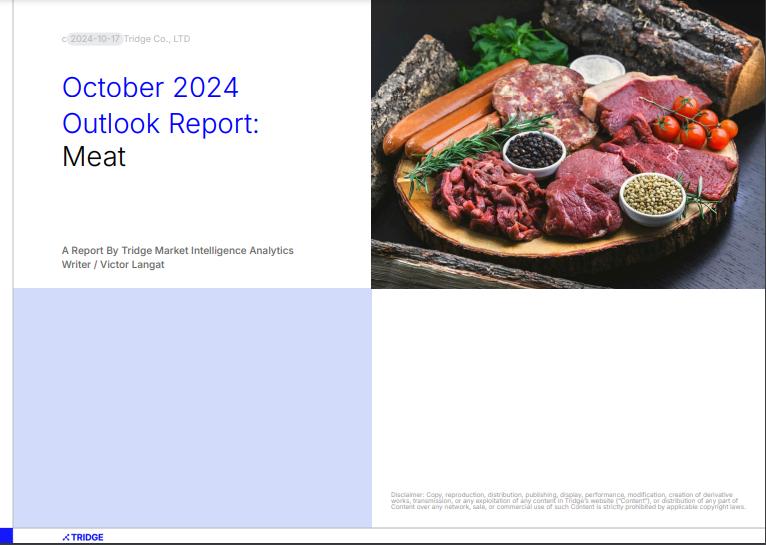PDF File Preview


- Key Indicators: Global freight prices dropped by 8% month-on-month (MoM) in Sep-24, averaging USD 4,836.65 per 40-foot container. This decline is largely attributed to the closing of the peak season for shipments to Northern Europe and the Mediterranean. Meanwhile, the Food and Agriculture Organization (FAO) meat price index averaged 119.59 points in Sep-24, a 0.35% increase from 119.17 points in Aug-24.
- Beef: Beef prices in the United States (US) are projected to continue rising in Oct-24, primarily due to limited exportable supplies caused by domestic supply constraints and strong demand from Middle Eastern markets. In Brazil, beef export prices are also expected to increase, driven by robust global demand and diversification of destination markets. Meanwhile, Australian beef prices are forecasted to rebound in Oct-24, supported by strong demand from the US, especially after the International Longshoremen's Association (ILA) called off its strike, easing export logistics. In the European Union (EU), ongoing supply constraints are anticipated to keep beef prices elevated throughout Oct-24.
- Poultry: Chicken prices in the US are expected to remain sluggish in Oct-24, mainly due to reduced global demand for US poultry following the avian influenza outbreak. In contrast, Brazil's chicken export prices are projected to increase, fueled by strong global demand. In the EU, poultry prices are expected to continue rising, driven by growing consumer demand for poultry as a cost-effective alternative to other meats and reduced competition from imported products.
- Pork: Pork prices in the US are expected to remain relatively stable in Oct-24, supported by strong global demand and sufficient exportable supplies. In Brazil, pork export prices are anticipated to continue trending upward, driven by robust international demand. Conversely, pork prices in the EU are projected to keep declining, as increased market supplies coincide with sluggish domestic demand.
- Lamb: Lamb prices in Australia are expected to decline in Oct-24, driven by reduced import demand, particularly from China. Meanwhile, in New Zealand, lamb prices are projected to keep rising due to limited supply, which is creating upward pressure on prices.
- Beef: Beef prices in the United States (US) are projected to continue rising in Oct-24, primarily due to limited exportable supplies caused by domestic supply constraints and strong demand from Middle Eastern markets. In Brazil, beef export prices are also expected to increase, driven by robust global demand and diversification of destination markets. Meanwhile, Australian beef prices are forecasted to rebound in Oct-24, supported by strong demand from the US, especially after the International Longshoremen's Association (ILA) called off its strike, easing export logistics. In the European Union (EU), ongoing supply constraints are anticipated to keep beef prices elevated throughout Oct-24.
- Poultry: Chicken prices in the US are expected to remain sluggish in Oct-24, mainly due to reduced global demand for US poultry following the avian influenza outbreak. In contrast, Brazil's chicken export prices are projected to increase, fueled by strong global demand. In the EU, poultry prices are expected to continue rising, driven by growing consumer demand for poultry as a cost-effective alternative to other meats and reduced competition from imported products.
- Pork: Pork prices in the US are expected to remain relatively stable in Oct-24, supported by strong global demand and sufficient exportable supplies. In Brazil, pork export prices are anticipated to continue trending upward, driven by robust international demand. Conversely, pork prices in the EU are projected to keep declining, as increased market supplies coincide with sluggish domestic demand.
- Lamb: Lamb prices in Australia are expected to decline in Oct-24, driven by reduced import demand, particularly from China. Meanwhile, in New Zealand, lamb prices are projected to keep rising due to limited supply, which is creating upward pressure on prices.
Table of Content
Part I: Key Indicators
- Freight
- FAO Meat Index
Part II: Beef
- United States
- Brazil
- Australia
- European Union
Part III: Poultry
- United States
- Brazil
- European Union
Part IV: Pork
- United States
- Brazil
- European Union
Part V: Lamb
- New Zealand
- Australia
Related market data
Read more relevant content
By clicking “Accept Cookies,” I agree to provide cookies for statistical and personalized preference purposes. To learn more about our cookies, please read our Privacy Policy.






